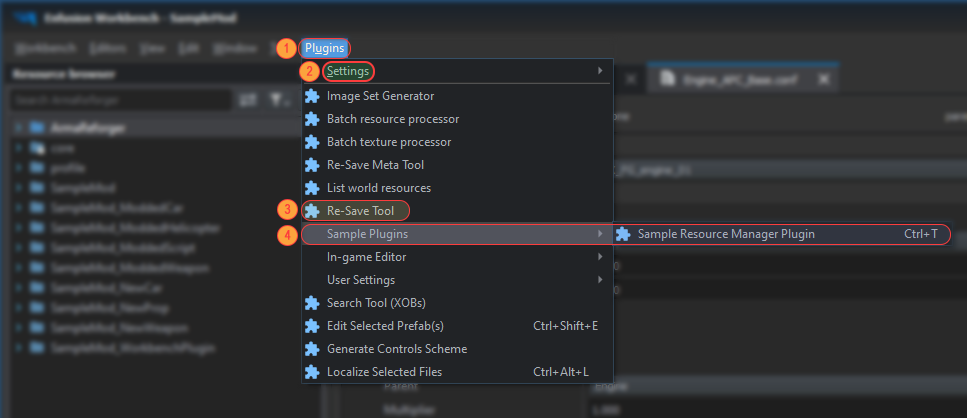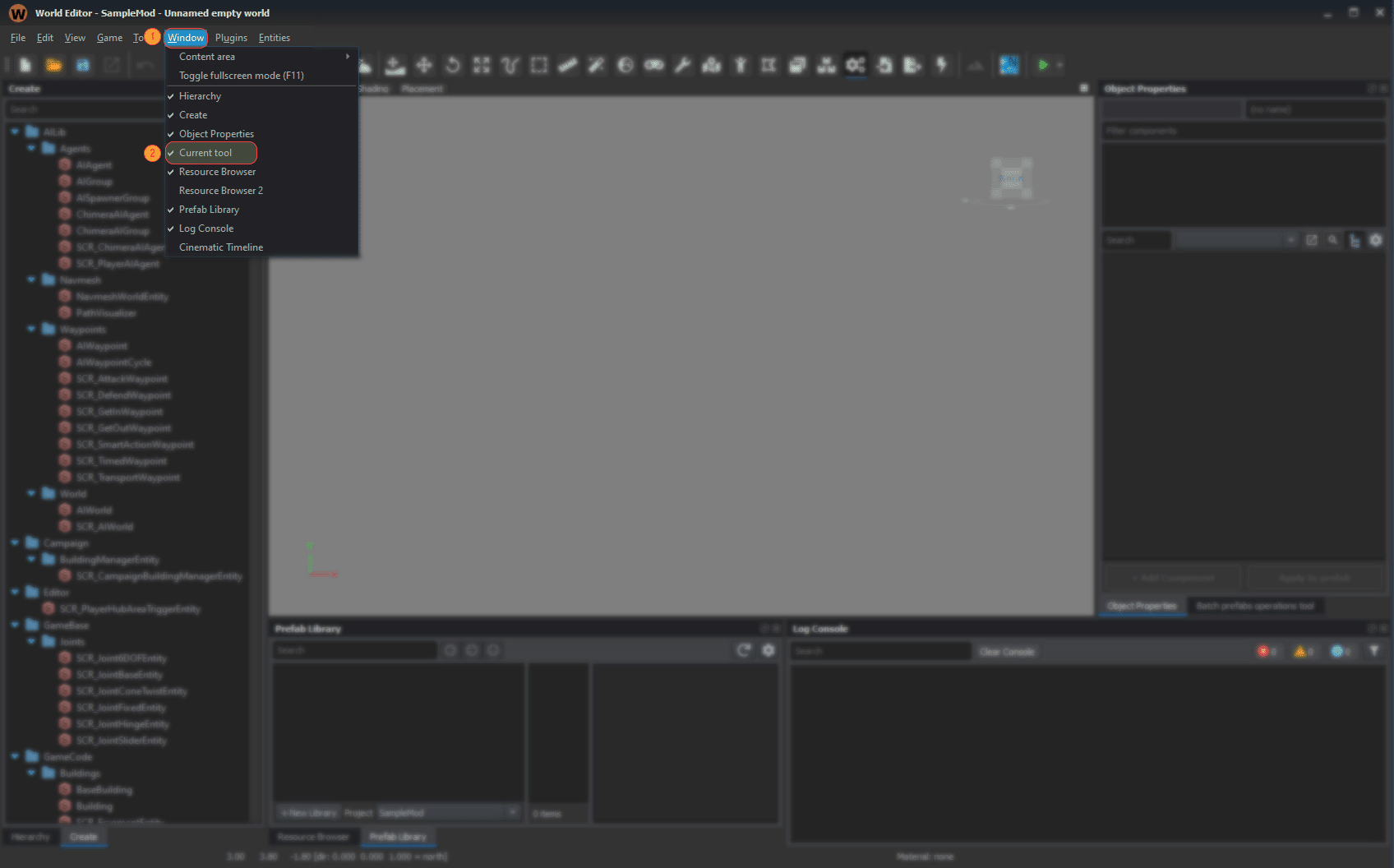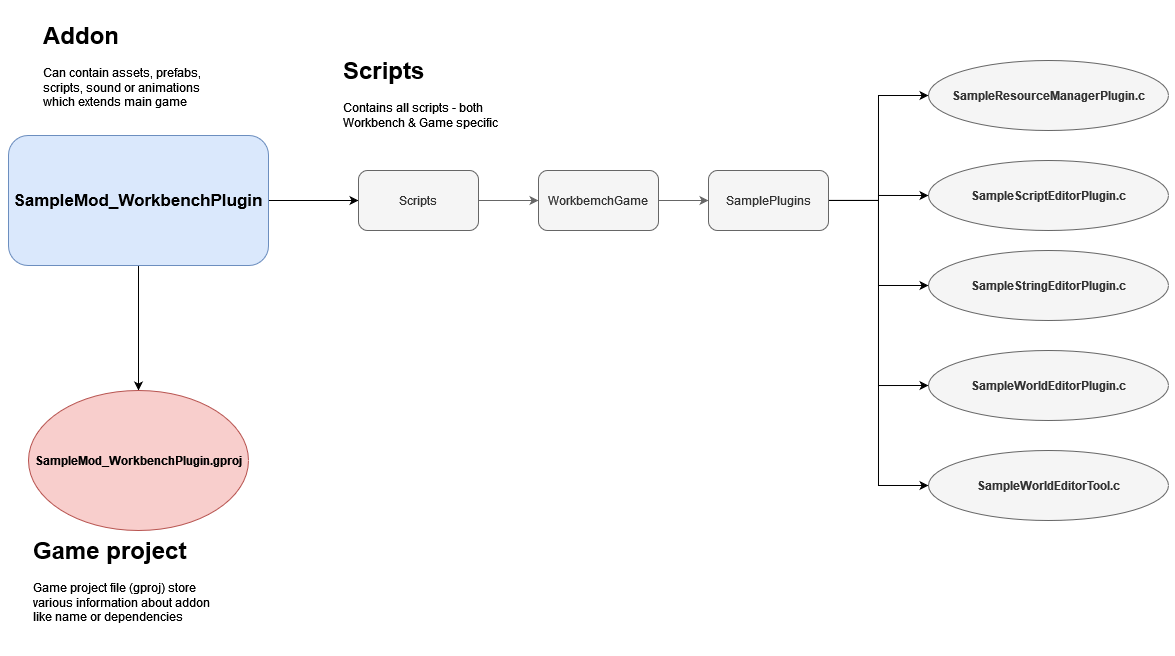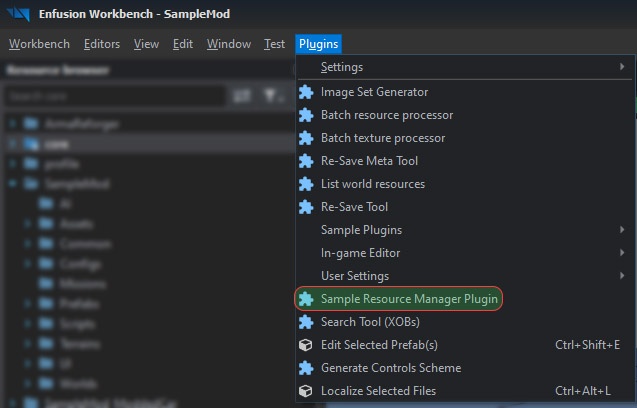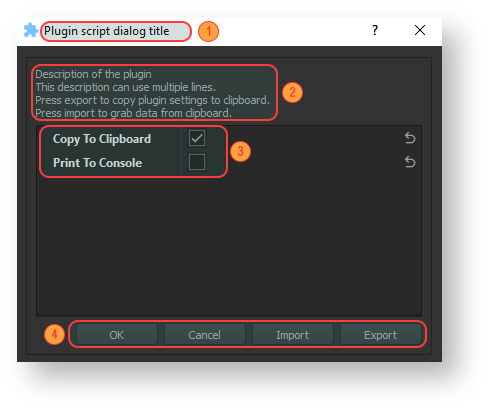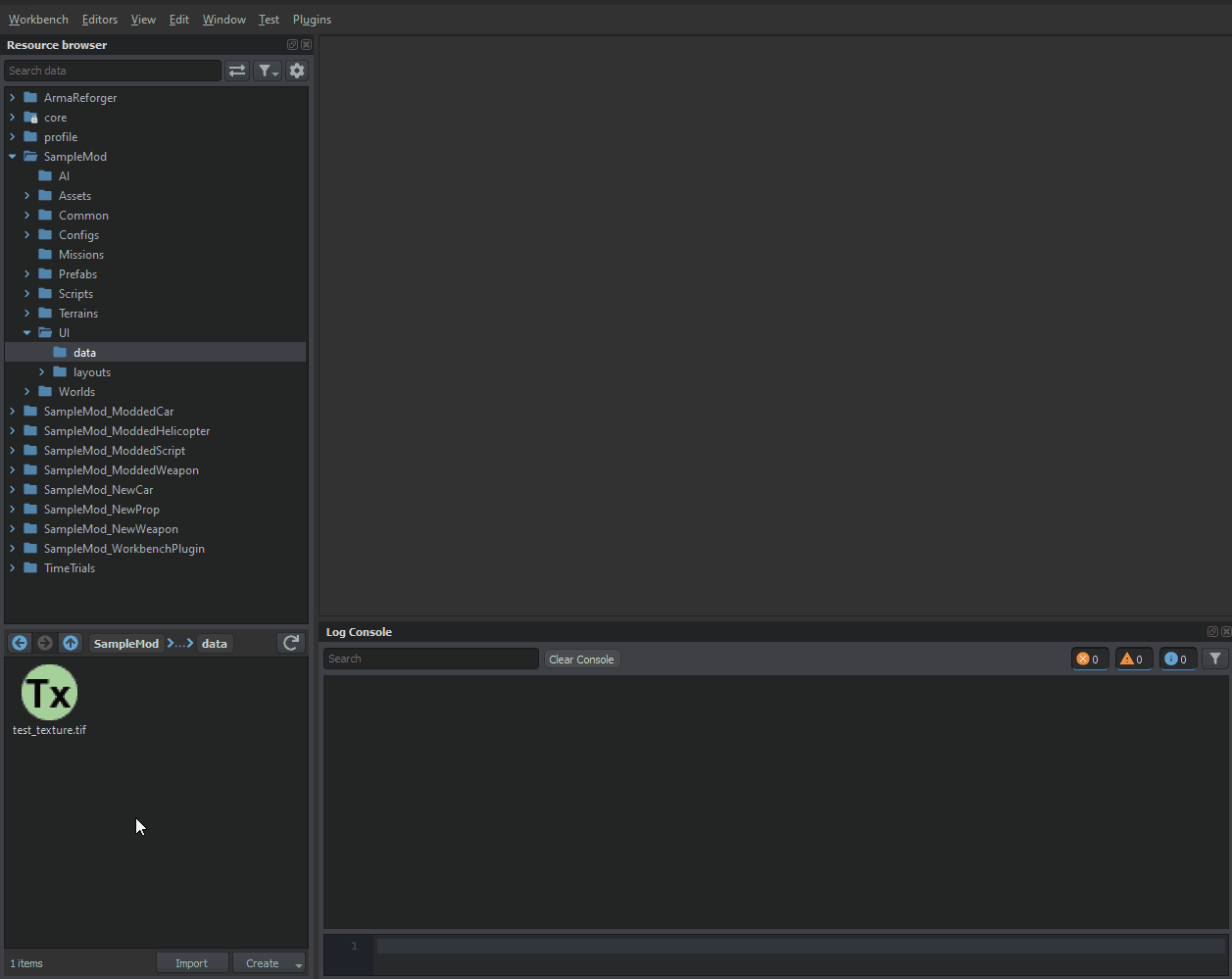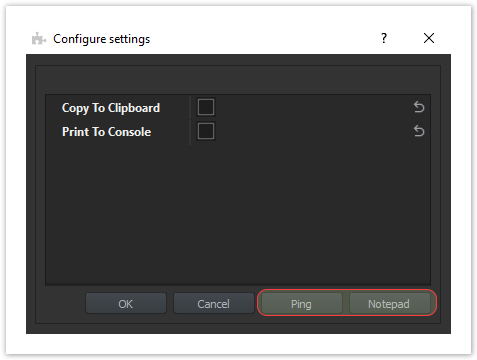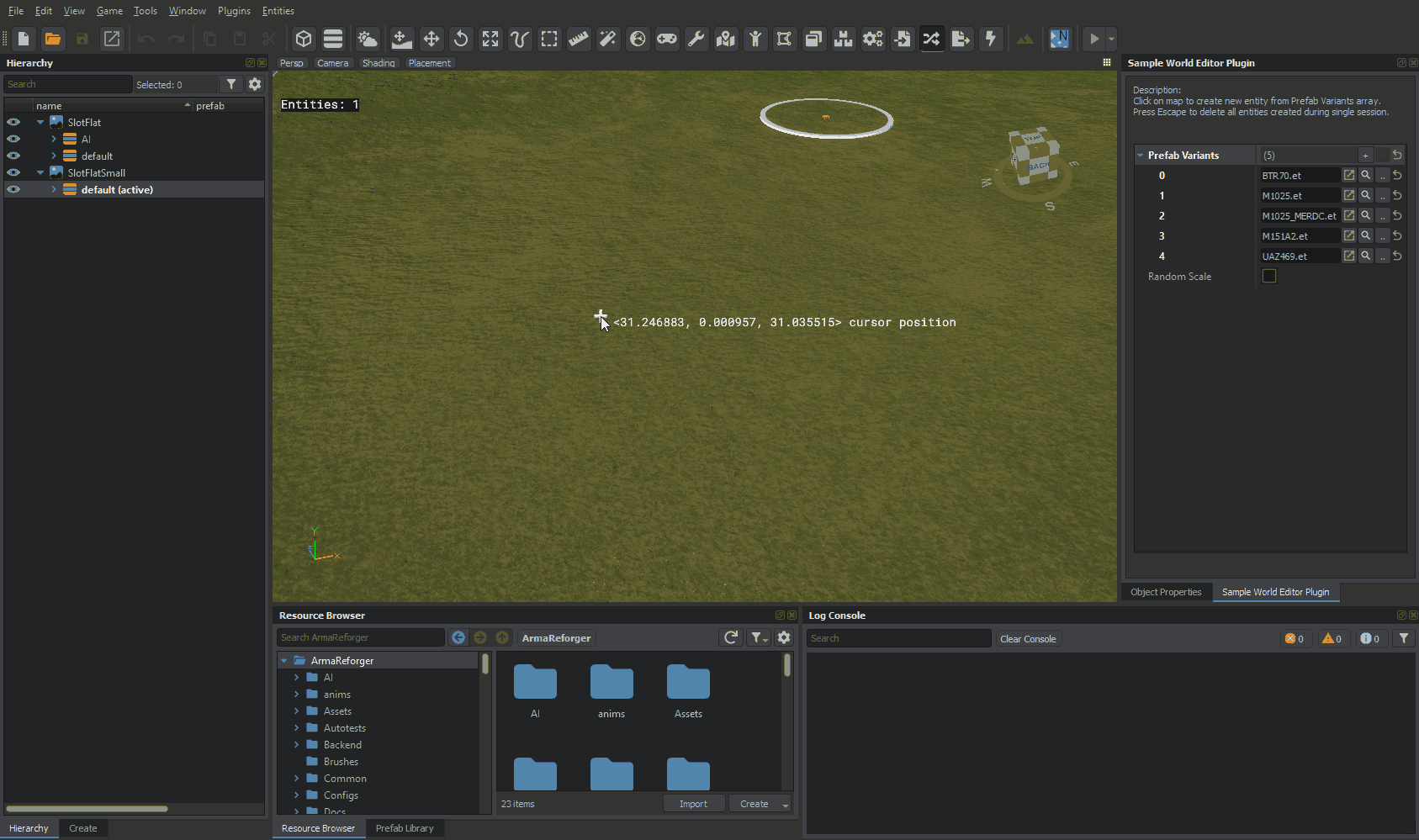Workbench Plugin Tutorial – Arma Reforger
Lou Montana (talk | contribs) (Page creation) |
(Added pictures) |
||
| Line 1: | Line 1: | ||
{{TOC|side}} | {{TOC|side}} | ||
Workbench allows to extend its functionality to certain degree. With help of scripts, you can create plugins for '''Resource Manager, Script Editor, String Editor & World Editor'''. Furthermore, you can also create additional tools for World Editor. | Workbench allows to extend its functionality to certain degree. With help of scripts, you can create plugins for '''Resource Manager, Script Editor, String Editor & World Editor'''. Furthermore, you can also create additional tools for World Editor. | ||
| Line 22: | Line 21: | ||
Plugin can be located in top toolbar in "Plugins" section '''(1)'''. From there, you can either select one of the already existing plugins '''(3)''' or change their settings in Settings sub menu '''(2)'''. Plugins can be also organized in submenus '''(4)''', so you can conveniently gather multiple plugins. | Plugin can be located in top toolbar in "Plugins" section '''(1)'''. From there, you can either select one of the already existing plugins '''(3)''' or change their settings in Settings sub menu '''(2)'''. Plugins can be also organized in submenus '''(4)''', so you can conveniently gather multiple plugins. | ||
[[Image:armareforger-workbench-plugin-category-usage.png]] | |||
{{Feature|informative|It is worth noting that each editor has its own API. Some of the functionalities available in World Editor's API (like the ability to modify prefabs) might not be available in Resource Manager and vice versa.}} | {{Feature|informative|It is worth noting that each editor has its own API. Some of the functionalities available in World Editor's API (like the ability to modify prefabs) might not be available in Resource Manager and vice versa.}} | ||
| Line 29: | Line 30: | ||
By default, World Editor Tools can be found right above the preview window of '''World Editor.''' | By default, World Editor Tools can be found right above the preview window of '''World Editor.''' | ||
[[Image:armareforger-workbench-plugin-world-editor-tools.png]] | |||
Some of those tools are part of the engine and some of them are scripted. Once some tool is selected, you can change its properties. | Some of those tools are part of the engine and some of them are scripted. Once some tool is selected, you can change its properties. | ||
To start using World Editor Tools, make sure that you have enabled '''Current Tool (2)''' window in '''Windows tab (1)'''. Once you have that completed, you can pick one of the Tools either from the '''tool bar (3)''' or from '''Tools''' category''''''. After that, you can go to the '''Current Tool tab''' | To start using World Editor Tools, make sure that you have enabled '''Current Tool (2)''' window in '''Windows tab (1)'''. Once you have that completed, you can pick one of the Tools either from the '''tool bar (3)''' or from '''Tools''' category''''''. After that, you can go to the '''Current Tool tab (4)''' and change parameters of '''currently selected tool (5)'''. | ||
[[Image:armareforger-workbench-plugin-world-tools-steps.gif]] | |||
'''World Editor Tools''' are often used to assist with prefab management (like spawning assets) but they can be also used for autotests due to ability to switch to game mode. | '''World Editor Tools''' are often used to assist with prefab management (like spawning assets) but they can be also used for autotests due to ability to switch to game mode. | ||
| Line 42: | Line 47: | ||
All your new plugins and tools should be located in '''Scripts/WorkbenchGame''' folder. It is possible to have them in some sub folder to keep structure bit more clear and in this tutorial '''SamplePlugins''' subfolder will collect all new scripts. | All your new plugins and tools should be located in '''Scripts/WorkbenchGame''' folder. It is possible to have them in some sub folder to keep structure bit more clear and in this tutorial '''SamplePlugins''' subfolder will collect all new scripts. | ||
[[Image:armareforger-workbench-plugin-structure.png]] | |||
In '''SamplePlugin''' folder, we will create in total 5 new scripts: | In '''SamplePlugin''' folder, we will create in total 5 new scripts: | ||
| Line 57: | Line 62: | ||
| '''Resulting file structure''' | | '''Resulting file structure''' | ||
|- | |- | ||
! | ![[Image:armareforger-workbench-plugin-creating-script.png]] | ||
! | ![[Image:armareforger-workbench-plugin-script-structure.png]] | ||
|} | |} | ||
| Line 105: | Line 110: | ||
The above code should result in a new entry in the '''Resource Manager''' plugins tab. | The above code should result in a new entry in the '''Resource Manager''' plugins tab. | ||
[[Image:armareforger-workbench-plugin-rm-plugin.jpg]] | |||
Now it is time to test the plugin in action! Clicking on '''Sample Resource Manager Plugin''' in the Plugins tab should result in "I'm here!" being printed in the '''Log Console'''. | Now it is time to test the plugin in action! Clicking on '''Sample Resource Manager Plugin''' in the Plugins tab should result in "I'm here!" being printed in the '''Log Console'''. | ||
[[Image:armareforger-workbench-plugin-rm-plugin-console.jpg]] | |||
=== Workbench Attribute === | === Workbench Attribute === | ||
| Line 159: | Line 167: | ||
On https://fontawesome.com/cheatsheet webpage you can try to find suitable icon for you. Let's say you are interested in '''copy''' icon. On the right you can see code for that icon - in this case it's '''f0c5''' | On https://fontawesome.com/cheatsheet webpage you can try to find suitable icon for you. Let's say you are interested in '''copy''' icon. On the right you can see code for that icon - in this case it's '''f0c5''' | ||
[[Image:armareforger-workbench-plugin-awesome-font.png|Center]] | |||
{{Clear}} | |||
To use that icon in Workbench, add '''awesomeFontCode''' parameter to '''WorkbenchPluginAttribute''' with following data - '''0x'''f0c5. '''0x is prefix which is required by the Wokrbench.''' | To use that icon in Workbench, add '''awesomeFontCode''' parameter to '''WorkbenchPluginAttribute''' with following data - '''0x'''f0c5. '''0x is prefix which is required by the Wokrbench.''' | ||
| Line 166: | Line 176: | ||
As result, you should get following thing in '''Workbench''' | As result, you should get following thing in '''Workbench''' | ||
'''''1''' - category, '''2''' - icon'' | [[Image:armareforger-workbench-plugin-awesome-font-icon.png|Left|800px|'''''1''' - category, '''2''' - icon'']] | ||
{{Clear}} | |||
; Full WorkbenchPluginAttribute code | ; Full WorkbenchPluginAttribute code | ||
| Line 200: | Line 210: | ||
<syntaxhighlight lang="c#">Workbench.ScriptDialog("Plugin script dialog title", "Description of the plugin\nThis description can use multiple lines.", this);</syntaxhighlight> | <syntaxhighlight lang="c#">Workbench.ScriptDialog("Plugin script dialog title", "Description of the plugin\nThis description can use multiple lines.", this);</syntaxhighlight> | ||
[[Image:armareforger-workbench-plugin-script-dialog.png|center]] | |||
{{Clear}} | |||
ScriptDialog has 3 parameters which lets you change: | ScriptDialog has 3 parameters which lets you change: | ||
| Line 418: | Line 430: | ||
In this case, adding {{hl|shortcut: "Ctrl+T"}} to the attribute will result in the selected keybind to be displayed next to the plugin name. | In this case, adding {{hl|shortcut: "Ctrl+T"}} to the attribute will result in the selected keybind to be displayed next to the plugin name. | ||
[[Image:armareforger-workbench-plugin-shortcut.png]] | |||
=== Running through CLI parameter === | === Running through CLI parameter === | ||
| Line 499: | Line 513: | ||
You can add that code to '''SampleResourceManagerPlugin''' class and try to register a new resource in '''Workbench'''. If everything is done correctly, you should see name of newly registered resource in '''Log Console'''. | You can add that code to '''SampleResourceManagerPlugin''' class and try to register a new resource in '''Workbench'''. If everything is done correctly, you should see name of newly registered resource in '''Log Console'''. | ||
[[Image:armareforger-workbench-plugin-on-import.gif]] | |||
=== Calling Run command & external executables === | === Calling Run command & external executables === | ||
| Line 565: | Line 581: | ||
} | } | ||
</syntaxhighlight> | </syntaxhighlight> | ||
[[Image:armareforger-workbench-plugin-settings-buttons.png]] | |||
Below is example code for '''SampleResourceManagerPluginSettings''' plugin which inherits from '''SampleResourceManagerPlugin'''. Import & Export buttons were removed and instead of them, there is '''Ping''' & '''Notepad''' button. | Below is example code for '''SampleResourceManagerPluginSettings''' plugin which inherits from '''SampleResourceManagerPlugin'''. Import & Export buttons were removed and instead of them, there is '''Ping''' & '''Notepad''' button. | ||
| Line 749: | Line 767: | ||
Beside that, they can have name '''(1)''', parameters '''(3)''' and buttons '''(4)''' as plugin. | Beside that, they can have name '''(1)''', parameters '''(3)''' and buttons '''(4)''' as plugin. | ||
[[Image:armareforger-workbench-plugin-world-editor-toool-window.png]] | |||
Below is the minimal code required to create a new '''World Editor Tool'''. | Below is the minimal code required to create a new '''World Editor Tool'''. | ||
| Line 781: | Line 799: | ||
=== Example World Editor Tool code === | === Example World Editor Tool code === | ||
[[Image:armareforger-workbench-plugin-tool-test.gif]] | |||
Below is full '''World Editor Tool example''' which utilizes some of the '''World Editor API'''. Tool will try to create a random prefab at cursor position from pool of Prefab Variants provided by user (''tip: you can drag and drop multiple prefabs there!)'' and then randomize scale of that new entity. | Below is full '''World Editor Tool example''' which utilizes some of the '''World Editor API'''. Tool will try to create a random prefab at cursor position from pool of Prefab Variants provided by user (''tip: you can drag and drop multiple prefabs there!)'' and then randomize scale of that new entity. | ||
Revision as of 14:45, 14 July 2022
Workbench allows to extend its functionality to certain degree. With help of scripts, you can create plugins for Resource Manager, Script Editor, String Editor & World Editor. Furthermore, you can also create additional tools for World Editor.
In general, you can use both plugins & tools for various types of automation like:
- Batch processing files
- Automatic testing of assets
- Generating databases
- Performing automation task on action
Editor Plugins
Plugin can be located in top toolbar in "Plugins" section (1). From there, you can either select one of the already existing plugins (3) or change their settings in Settings sub menu (2). Plugins can be also organized in submenus (4), so you can conveniently gather multiple plugins.
World Editor Tools
By default, World Editor Tools can be found right above the preview window of World Editor.
Some of those tools are part of the engine and some of them are scripted. Once some tool is selected, you can change its properties.
To start using World Editor Tools, make sure that you have enabled Current Tool (2)' window in Windows tab (1). Once you have that completed, you can pick one of the Tools either from the tool bar (3) or from Tools category'. After that, you can go to the Current Tool tab (4) and change parameters of currently selected tool (5).
World Editor Tools are often used to assist with prefab management (like spawning assets) but they can be also used for autotests due to ability to switch to game mode.
It is also possible to drag & drop resources (like prefabs) into current tool properties, which is especially useful when you want to change multiple hand picked prefabs.
Preparing Data Structure
All your new plugins and tools should be located in Scripts/WorkbenchGame folder. It is possible to have them in some sub folder to keep structure bit more clear and in this tutorial SamplePlugins subfolder will collect all new scripts.
In SamplePlugin folder, we will create in total 5 new scripts:
- SampleResourceManagerPlugin.c - containing Resource Manager plugin code
- SampleScriptEditorPlugin.c - containing Script Editor plugin code
- SampleStringEditorPlugin.c - containing String Editor plugin code
- SampleWorldEditorPlugin.c - containing World Editor plugin code
- SampleWorldEditor.c - containing World Editor Tool code
Assuming that you have already created folders in way described above (either through system file explorer or through Workbench context menu available in Resource Browser), you can start creating empty script file by clicking on Resource Browse field (1) with ![]() which will invoke context menu. From there, you can select option to create a new empty script file with name of your choice. Alternatively, you can click on Create button (2) which will show you same context menu as previous method.
which will invoke context menu. From there, you can select option to create a new empty script file with name of your choice. Alternatively, you can click on Create button (2) which will show you same context menu as previous method.
| Creating script file | Resulting file structure |
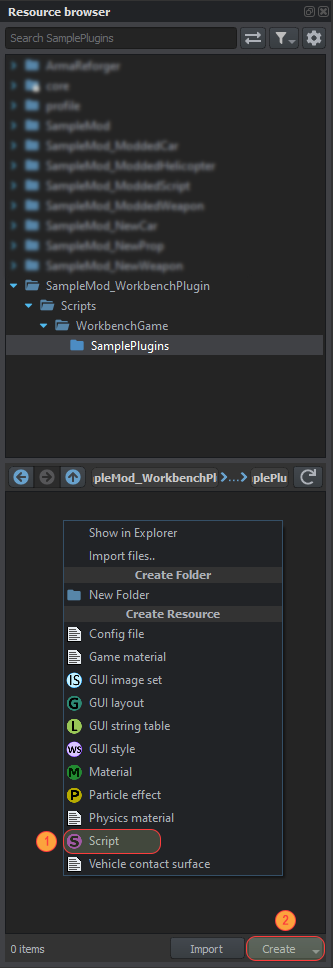
|
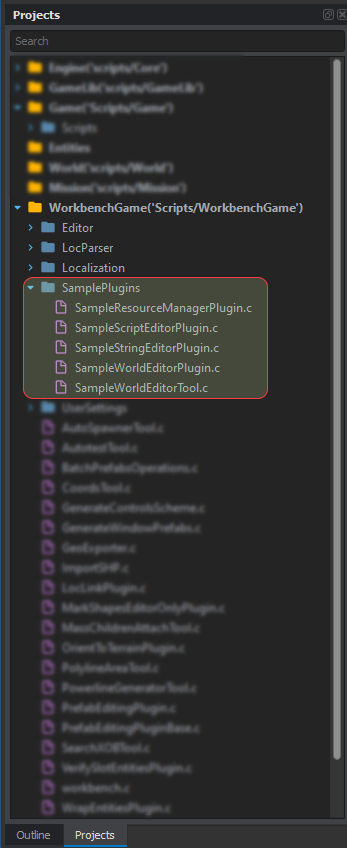
|
|---|
Resource Manager Plugin
Basic structure
At minimum, new plugin needs to inherit from WorkbenchPlugin class. This class offers you ability to define behaviour of the plugin when it's launched (either by clicking on it or by CLI parameter) or when its settings are being changed.
There are also few more specialized variants of WorkbenchPlugin class, which exposes additional API, like:
- ResourceManagerPlugin
- WorldEditorPlugin
- LocalizationEditorPlugin
Let's start with SampleResourceManagerPlugin.c and try to create some minimum code for new Wokrbench plugin which is visible in Resource Manager plugins tab.
One of the requirements was already listed above but let's summarize all ingredients necessary to create a new plugin:
- New plugin class needs to inherit from WorkbenchPlugin or its derivatives
- Needs WorkbenchPluginAttribute correctly defined
- Needs some code in Run() method
[WorkbenchPluginAttribute(name: "Sample Resource Manager Plugin", wbModules: { "ResourceManager" })]
class SampleResourceManagerPlugin : WorkbenchPlugin
{
override void Run()
{
Print("I'm here!");
}
}
The above code should result in a new entry in the Resource Manager plugins tab.
Now it is time to test the plugin in action! Clicking on Sample Resource Manager Plugin in the Plugins tab should result in "I'm here!" being printed in the Log Console.
Workbench Attribute
WorkbenchPluginAttribute defines how & where the plugin is going to be visible. We already have display name defined via name attribute & wbModules parameter to show this plugin only in Resource Manager. There are few more attributes which are quite handy when developing plugins.
| Parameter Name | Description |
|---|---|
name |
Name of the plugin/tool |
description |
Description of tool visible in Current Tool panel (only relevant to World Editor Tools) |
shortcut |
Keyboard shortcut in text format - "Ctrl+G" means that plugin will be activated after pressing left control & G on keyboard. |
icon |
Plugin custom PNG icon - it's recommended to use awesomeFontCode instead! |
wbModules |
List of strings representing Workbench modules where this tool should be avalaible (e.g. {"ResourceManager", "ScriptEditor"}). Leave null or empty array for any module |
category |
Category of the plugin ( see #4 ) - (not relevant to World Editor Tools) |
awesomeFontCode |
Hexadecimal code for Awesome icon.
|
Adding category parameter
Adding a new category is fairly simple as typing category: "Sample Plugins" into WorkbenchPluginAttribute is enough to add your plugin to "Sample Plugins" sub menu in the Plugins tab. Multiple plugins can be collected in one category if they all use same "category" parameter
Adding custom icon
First of all, it's recommended to use awesomeFontCode instead of icon parameter and that's why this paragraph only focus on usage of awesome font.
On https://fontawesome.com/cheatsheet webpage you can try to find suitable icon for you. Let's say you are interested in copy icon. On the right you can see code for that icon - in this case it's f0c5
To use that icon in Workbench, add awesomeFontCode parameter to WorkbenchPluginAttribute with following data - 0xf0c5. 0x is prefix which is required by the Wokrbench.
Custom icon
awesomeFontCode: 0xf0c5
As result, you should get following thing in Workbench
- Full WorkbenchPluginAttribute code
[WorkbenchPluginAttribute(name: "Sample Resource Manager Plugin", category: "Sample Plugins", wbModules: {"ResourceManager"}, awesomeFontCode: 0xf0c5)]
Expanding plugin functionality
It's time to expand plugin functionality!
In this chapter the Resource Manager plugin will be expanded with following options:
- Getting array of currently selected files in Resource Browser
- Printing array of selected files to Console Log
- Copying content of that array to the clipboard
[WorkbenchPluginAttribute(name: "Sample Resource Manager Plugin", category: "Sample Plugins", shortcut: "", wbModules: {"ResourceManager"})]
class SampleResourceManagerPlugin: WorkbenchPlugin
{
//----------------------------------------------------------------------------------------------
override void Run()
{
}
}
Settings
If the Configure() method is not empty, plugins settings can be accessed by selecting appropriate entry in Plugins → Settings tab (see #2).
Usually, you are going to use following code to invoke UI window to change plugin settings:
Workbench.ScriptDialog("Plugin script dialog title", "Description of the plugin\nThis description can use multiple lines.", this);
ScriptDialog has 3 parameters which lets you change:
- Title (1) - Title of the UI
- Text (2) - Text that is inside of UI dialog - it's useful to fill there i.e. usage instruction or general description of the plugin
- Data (3) - Data (parameters) that are passed to dialog. All members of the method with [Attribute] are exposed to this script dialog if "this" is used as last parameter.
Furthermore, dialog can be expanded with additional buttons (4), which can execute any code you want. All you have to do is to add [ButtonAttribute()] above the method.
ButtonAttribute(string label = "ScriptButton", bool focused = false)
This attribute has two parameters:
- label - string which is used as a display name in UI
- focused - boolean which controls if given button is by default focused. (default: false)
[ButtonAttribute("OK")]
void OkButton() {}
The above code will show simple "OK" button which doesn't do anything.
Below is bit more advanced example which lets you export & import current settings to clipboard.
// Plugins settings - those can be changed in Plugins -> Settings section
[Attribute("0", UIWidgets.CheckBox, "Check this option to print output to clipboard.")]
bool m_CopyToClipboard;
[Attribute("0", UIWidgets.CheckBox, "Check this option to print output array to the console log.")]
bool m_PrintToConsole;
// Simple ButtonAttributes which shows OK in dialog - no extra functonality
[ButtonAttribute("OK")]
void OkButton() {}
// Cancel button
[ButtonAttribute("Cancel")]
bool CancelButton()
{
return false;
}
// Button responsible for importing plugin parameters from clipboard
[ButtonAttribute("Import")]
void ImportButton()
{
// Get content of user clipboard
string input = System.ImportFromClipboard();
// Verify input
if(input == "") return;
// Parse input
array<string> parsedText = new array<string>;
input.Split(" ",parsedText,false);
// Verify parse input
int parsedTextCount = parsedText.Count();
if(parsedTextCount != 2)
{
PrintFormat("Invalid parameter count, typed %1 parameters while 2 were expected",parsedTextCount);
return;
}
// Update variables states according to clipboard data
m_CopyToClipboard = parsedText[0].ToInt();
m_PrintToConsole = parsedText[1].ToInt();
}
// Button responsible for exporting plugin parameters to clipboard
[ButtonAttribute("Export")]
void ExportButton()
{
string export;
export = string.Format("%1 %2",m_CopyToClipboard,m_PrintToConsole);
System.ExportToClipboard(export);
}
// Code which is executed when settings are accesed
override void Configure()
{
Workbench.ScriptDialog("Plugin script dialog title", "Description of the plugin\nThis description can use multiple lines.\nPress export to copy plugin settings to clipboard.\nPress import to grab data from clipboard.", this);
}
Below is full example which you can test yourself in Resource Manager. Try changing either Copy To Clipboard or Print To Console parameter and check how it behaves in Workbench.
[WorkbenchPluginAttribute(name: "Sample Resource Manager Plugin", category: "Sample Plugins", shortcut: "Ctrl+T", wbModules: { "ResourceManager" }, awesomeFontCode: 0xf0c5)]
class SampleResourceManagerPlugin: ResourceManagerPlugin
{
// Plugins settings - those can be changed in Plugins -> Settings section
[Attribute("0", UIWidgets.CheckBox, "Check this option to print output to clipboard.")]
bool m_CopyToClipboard;
[Attribute("0", UIWidgets.CheckBox, "Check this option to print output array to the console log.")]
bool m_PrintToConsole;
// ButtonAttributes
[ButtonAttribute("OK")]
void OkButton()
{
}
// Cancel button
[ButtonAttribute("Cancel")]
bool CancelButton()
{
return false;
}
// Button responsible for importing plugin parameters from clipboard
[ButtonAttribute("Import")]
void ImportButton()
{
// Get content of user clipboard
string input = System.ImportFromClipboard();
// Verify input
if (input == "")
return;
// Parse input
array<string> parsedText = new array<string>;
input.Split(" ", parsedText, false);
// Verify parse input
int parsedTextCount = parsedText.Count();
if (parsedTextCount != 2)
{
PrintFormat("Invalid parameter count, typed %1 parameters while 2 were expected", parsedTextCount);
return;
}
// Update variables states according to clipboard data
m_CopyToClipboard = parsedText[0].ToInt();
m_PrintToConsole = parsedText[1].ToInt();
}
// Button responsible for exporting plugin parameters to clipboard
[ButtonAttribute("Export")]
void ExportButton()
{
string export = string.Format("%1 %2",m_CopyToClipboard,m_PrintToConsole);
System.ExportToClipboard(export);
}
// Code which is executed when settings are accesed
override void Configure()
{
Workbench.ScriptDialog("Plugin script dialog title", "Description of the plugin\nThis description can use multiple lines.\nPress export to copy plugin settings to clipboard.\nPress import to grab data from clipboard.", this);
}
// This code is executed when plugin is executed either by clicking on it in Plugins list or when shortcut is used
override void Run()
{
// Grab reference to ResourceManager
ResourceManager resourceManager = Workbench.GetModule(ResourceManager);
if (!resourceManager)
return;
// Get list of currently selected resources
array<ResourceName> selection = new array<ResourceName>;
SCR_WorkbenchSearchResourcesCallbackArray context = new SCR_WorkbenchSearchResourcesCallbackArray(selection);
resourceManager.GetResourceBrowserSelection(context.Insert, true);
// Verify if something is selected - if no, exit method & print error message
if (selection.IsEmpty())
{
Print("No elements are selected in Resource Browser");
return;
}
if (m_PrintToConsole)
{
// Print ResourceManager selection directly to the console
Print(selection);
}
if (m_CopyToClipboard)
{
// Copy file name to clipboard - each element will be written on new line
string export;
foreach (string element : selection)
{
export = export + "element: " + element + "\n";
}
System.ExportToClipboard(export);
}
}
}
Key shortcuts
Shortcuts can be easily added by changing shortcut parameter in WorkbenchPluginAttribute of plugin.
[WorkbenchPluginAttribute(name: "Sample Resource Manager Plugin", category: "Sample Plugins", shortcut: "Ctrl+T", wbModules: { "ResourceManager" })]
In this case, adding shortcut: "Ctrl+T" to the attribute will result in the selected keybind to be displayed next to the plugin name.
Running through CLI parameter
Beside launching plugin from the Workbench itself, it is also possible to launch selected plugins through CLI parameter on Workbench shortcut, which is really useful when creating some automation systems.
To do so, first specify in wbModule name of the module which plugin relays on (in this case its ResourceManager) and then type name of the plugin in -plugin parameter.
O:\PathToReforger\ArmaReforgerWorkbench.exe -wbmodule=ResourceManager -plugin=SampleResourceManagerPlugin
Furthermore, you can also read custom command line parameters which are passed to the Workbench via GetCmdLine method! To do so, add additional parameter in your shortcut after -plugin=SampleResourceManagerPlugin (see Startup Parameters).
O:\PathToReforger\ArmaReforgerWorkbench.exe -wbmodule=ResourceManager -plugin=SampleResourceManagerPlugin -myParameter="$ArmaReforger:Prefabs\Vehicles"
After that, you can fetch myParameter from the script via the GetCmdLine() method.
override void RunCommandline()
{
ResourceManager resourceManager = Workbench.GetModule(ResourceManager);
string param = "";
resourceManager.GetCmdLine("-myParameter", param);
}
Below is bit more advanced example which you can use in SampleResourceManagerPlugin. This code will copy to clipboard total amount of prefabs in selected location. By default code is working without any extra parameters and is looking for prefabs in "$ArmaReforger:". You can change search location through myParameter - example -myParameter="$ArmaReforger:Prefabs\Vehicles"
Optionally, you can also use -autoclose=1 parameter to automatically close Workbench once search for prefabs was completed.
override void RunCommandline()
{
ResourceManager resourceManager = Workbench.GetModule(ResourceManager);
// Default values
string param = "$ArmaReforger:";
string autoclose = "0";
// First parameter called myParameter
resourceManager.GetCmdLine("-myParameter", param);
resourceManager.GetCmdLine("-autoclose", autoclose);
// Print parameters in console
PrintFormat("CLI parameters -myParameter= %1 -autoClose=%2",param,autoclose);
// Find any .et (prefab) files in selected location
array<string> files = {};
System.FindFiles(files.Insert, param, ".et");
int numberOfFiles = files.Count();
// Print number of all files to Log Console
Print(numberOfFiles);
// Export to clipboard result of the search
System.ExportToClipboard("Number of all .et files in " + param + " = " + numberOfFiles.ToString());
// Close workbench if autoclose parameter is set to 1
if (autoclose == "1")
Workbench.Exit(0);
}
Running plugin on event
Some of the Workbench editors supports additional actions which are executed when some event is triggered. As per info in this paragraph, you can check workbench.c file and look for classes which inherits from WorkbenchPlugin.
In below example, we are going to use OnRegisterResource method located in ResourceManagerPlugin. This method is called every time some resource is registered in Workbench. Whenever it happens, OnRegisterResource is called and you can use two parameters that are exposed there:
- absFileName - which is absolute path + name of newly registered file
- metaFile - link to meta file which was created during that process
// This method is executed every time some new resource is registered
override void OnRegisterResource(string absFileName, BaseContainer metaFile)
{
// Print directly to the Log Console absolute path & file name of newly registered resource
Print(absFileName);
}
You can add that code to SampleResourceManagerPlugin class and try to register a new resource in Workbench. If everything is done correctly, you should see name of newly registered resource in Log Console.
Calling Run command & external executables
Workbench provides API for running Run command & executing external executables. This achieved by two Workbench methods
| Method | Description | Parameters | Return |
|---|---|---|---|
| int RunCmd(string command, bool wait = false); | Run command - https://en.wikipedia.org/wiki/Run_command | string command - command to run
bool wait - tells whether Workbench should wait till command is completed |
If wait is used, exit code represented as integer is returned. Otherwise 0 is returned |
| ProcessHandle RunProcess(string command); | Executes selected proccess | string command - process to run | Returns handle to process which can be used to i.e. check if application was launched or to kill it later |
RunCmd allows to execute any Run command available on operating system.
In below example, a new button Ping is added to the plugin settings, which executes RunCmd & pings bohemia.net page. Once pinging is completed, Cmd.exe window will be closed.
[ButtonAttribute("Ping")]
void PingBohemia()
{
// Ping bohemia.net page
Workbench.RunCmd("ping bohemia.net");
}
RunProcess can be used to any executable on PC. This method returns also handle to the process so you can check whether process was executed successfully or terminate it once some condition is reached.
In this example, Windows notepad is launched after pressing Notepad button in UI. If process was launched sucesfully, notepad will be closed after two seconds.
void KillProcess(ProcessHandle handle)
{
// Sleep is in milliseconds!
Sleep(2000);
// Kill process passed to this method
Workbench.KillProcess(handle);
}
[ButtonAttribute("Notepad")]
void OpenNotepad()
{
// Open notepad
ProcessHandle handle = Workbench.RunProcess("notepad");
if (!handle)
{
Print("Couldn't start the notepad.", LogLevel.ERROR);
return;
}
// Run separate thread where notepad will be killed after 2000 miliseconds
thread KillProcess(handle);
}
Below is example code for SampleResourceManagerPluginSettings plugin which inherits from SampleResourceManagerPlugin. Import & Export buttons were removed and instead of them, there is Ping & Notepad button.
// Variant of the plugin which opens settings UI on each run - inherits from basic SampleResourceManagerPlugin
[WorkbenchPluginAttribute(name: "Sample Resource Manager Plugin (Settings)", category: "Sample Plugins", shortcut: "Ctrl+R", wbModules: { "ResourceManager" }, awesomeFontCode: 0xf085)]
class SampleResourceManagerPluginSettings: SampleResourceManagerPlugin
{
// We don't want import & export buttons anymore. Overriding without providing ButtonAttribute above it is enough to stop it from showing
override void ImportButton() {}
override void ExportButton() {}
void KillProcess(ProcessHandle handle)
{
// Sleep is in miliseconds!
Sleep(2000);
// Kill process passed to this method
Workbench.KillProcess(handle);
}
[ButtonAttribute("Ping")]
void PingBohemia()
{
// Ping bohemia.net page
Workbench.RunCmd("ping bohemia.net");
}
[ButtonAttribute("Notepad")]
void OpenNotepad()
{
// Open notepad
ProcessHandle handle = Workbench.RunProcess("notepad");
if (!handle)
{
Print("Couldn't start the notepad.", LogLevel.ERROR);
return;
}
// Run separate thread where notepad will be killed after 2000 miliseconds
thread KillProcess(handle);
}
override void Configure()
{
Workbench.ScriptDialog("Configure settings", "", this);
}
override void Run()
{
Workbench.ScriptDialog("Configure settings", "", this);
super.Run();
}
}
Script Editor plugin
This simple plugin is going to print name of currently selected script & currently selected line in Script Editor. In principle, most of the plugin functionality was already above so this plugin is mainly to showcase possibilities lying in the API that various editors have.
Plugin can be activated either by selecting it in Plugins → Sample Plugins → Sample Script Editor Plugin or through the Ctrl + T shortcut.
[WorkbenchPluginAttribute(name: "Sample Script Editor Plugin", category: "Sample Plugins", shortcut: "Ctrl+T", wbModules: { "ScriptEditor" })]
class SampleScriptEditorPlugin: WorkbenchPlugin
{
override void Run()
{
ScriptEditor scriptEditor = Workbench.GetModule(ScriptEditor);
if (! scriptEditor) return;
// Try to get currently selected file
string file;
if (!scriptEditor.GetCurrentFile(file) )
{
Print("No file is currently selected!");
return;
}
// Try to get absolute path to currently selected file
string absPath;
if (!Workbench.GetAbsolutePath(file, absPath) )
{
Print("Workbench was unable to get absolute path of selected file!");
return;
}
// Print local & absolute path of currently opened file
Print(file);
Print(absPath);
// Print current Line
string currentLine;
scriptEditor.GetLineText(currentLine, -1);
Print(currentLine);
// Copy file name to clipboard
System.ExportToClipboard(file);
}
}
String Editor plugin
This String Editor example plugin prints to the Log Console currently opened file & selected rows in this editor. Additionally, the name of the currently selected file is also copied to the user clipboard. This example plugin has no options available.
[WorkbenchPluginAttribute(name: "Sample String Editor Plugin", category: "Sample Plugins", shortcut: "Ctrl+T", wbModules: {"LocalizationEditor"}, awesomeFontCode: 0xf02d)]
class SampleStringEditorPlugin: LocalizationEditorPlugin
{
override void Run()
{
LocalizationEditor localizationEditor = Workbench.GetModule(LocalizationEditor);
if (! localizationEditor)
return;
array<int> selectedIndexes = new array<int>;
localizationEditor.GetSelectedRows(selectedIndexes);
Print(selectedIndexes);
}
}
Creating World Editor Extensions
Compared to all other editors, World Editor is exposing to user much more functions than any other Workbench module. Beside World Editor API in workbench.c file, there is another in worldEditor.c file inside of WorldEditorAPI.
Among things that are possible to do in World Editor:
- Terrain manipulation
- Game mode creation assistance
- Loading scenarios and performing autotests
- Making edits to prefabs or configs
World Editor Plugin
This simple plugin is showing amount of currently selected entities in World Editor. You can invoke it by pressing Ctrl + T or by selecting it from the Plugins tab.
[WorkbenchPluginAttribute(name: "Sample World Editor Plugin", category: "Sample Plugins", shortcut: "Ctrl+T", wbModules: {"WorldEditor"})]
class SampleWorldEditorPlugin: WorldEditorPlugin
{
override void Run()
{
// Get World Editor module
WorldEditor worldEditor = Workbench.GetModule(WorldEditor);
// Get World Editor API
WorldEditorAPI api = worldEditor.GetApi();
int selectedEntitiesCount;
selectedEntitiesCount = api.GetSelectedEntitiesCount();
// Print result to the Log Console
Print(selectedEntitiesCount);
}
}
World Editor Tool
Setting up new Tool
As indicated before, World Editor Tools has quite impressive API which can be used in many different ways. There are few subtle differences between World Editor Tools and plugins which are worth to note like:
- Usage of WorkbenchToolAttribute (which shares available parameters with plugin - see Workbench Attribute) to expose it to World Editor
- Inheritance from WorldEditorTool class, which has different pool of methods available compared to plugins
- They cannot be launched via CLI parameter
- They can use description parameter (2)
- They are not grouped in categories like plugins, therefore category parameter is not relevant for them
Beside that, they can have name (1), parameters (3) and buttons (4) as plugin.
Below is the minimal code required to create a new World Editor Tool.
[WorkbenchToolAttribute(name: "Sample World Editor Plugin", description: "Description of plugin.\nSupports multiple lines.", wbModules: { "WorldEditor" }, awesomeFontCode: 0xf074)]
class SampleWorldEditorTool : WorldEditorTool
{
}
Using World Editor API
When performing any operations to entities, you need to call BeginEntityAction, which marks start of logical edit actions. Use m_API.EndEntityAction(); to mark end of edit actions. All transformations between BeginEntityAction & EndEntityAction are used by World Editor history stack - such actions can be reverted by user either via Undo last action button or shortcut (Ctrl+Z).
In below example code is creating a new entity and applies random scale to it.
m_API.BeginEntityAction("Processing entity");
// Create entity using one of the selected random prefabs
IEntity entity = m_API.CreateEntity(m_PrefabVariants.GetRandomElement(), "", m_API.GetCurrentEntityLayerId(), null, traceEnd, vector.Zero);
m_arrayOfEntities.Insert(entity);
m_API.ModifyEntityKey(entity, "scale", (Math.RandomFloat(0.5,2)).ToString());
m_API.EndEntityAction();
Example World Editor Tool code
Below is full World Editor Tool example which utilizes some of the World Editor API. Tool will try to create a random prefab at cursor position from pool of Prefab Variants provided by user (tip: you can drag and drop multiple prefabs there!) and then randomize scale of that new entity.
Entity creation happens on left mouse button ![]() press and after that, tool will try to rotate that new entity in direction where mouse button was located when button was released.
press and after that, tool will try to rotate that new entity in direction where mouse button was located when button was released.
All entities created by that tool can be deleted by pressing Escape key or by clicking on Delete all button in Current Tool tab. Additionally you can also use Randomize scale button to randomize scale of all entities created with this tool.
[WorkbenchToolAttribute(name: "Sample World Editor Tool", description: "Click on map to create new entity from Prefab Variants array.\nPress Escape to delete all entities created during single session.", wbModules: { "WorldEditor" }, awesomeFontCode: 0xf074)]
class SampleWorldEditorTool: WorldEditorTool
{
[Attribute("", UIWidgets.ResourceAssignArray, "Pool of prefabs for placement randomizer.", "et")]
protected ref array<ResourceName> m_PrefabVariants;
[Attribute("0", UIWidgets.CheckBox, "Randomize scale of placed objects.")]
bool m_RandomScale;
ref DebugTextScreenSpace m_text;
ref DebugTextScreenSpace m_crossHair;
ref array<IEntity> m_arrayOfEntities;
vector m_previousTraceEnd;
// Delete all button
[ButtonAttribute("Delete all")]
void DeleteAll()
{
// Do nothing if array is empty
if(!m_arrayOfEntities)
return;
// Delete all entities created by this tool
m_API.BeginEntityAction("Deleting entities");
m_API.DeleteEntities(m_arrayOfEntities);
m_API.EndEntityAction();
m_arrayOfEntities.Clear();
}
// Randomize scale button
[ButtonAttribute("Randomize scale")]
void RandomizeScale()
{
// Do nothing if array is empty
if(!m_arrayOfEntities)
return;
// Delete all entities created by this tool
m_API.BeginEntityAction("Changing scale of entities");
foreach (int currentIndex, IEntity entity: m_arrayOfEntities)
{
m_API.ModifyEntityKey(entity, "scale", (Math.RandomFloat(0.5,2)).ToString());
}
m_API.EndEntityAction();
}
// Method called on mouse movement
override void OnMouseMoveEvent(float x, float y)
{
vector traceStart;
vector traceEnd;
vector traceDir;
m_crossHair.SetTextColor(ARGBF(1, 1.0, 1.0, 1.0));
m_text.SetTextColor(ARGBF(1, 1.0, 1.0, 1.0));
m_crossHair.SetPosition(x - 9, y - 16);
m_crossHair.SetText("+");
m_text.SetPosition(x + 15, y);
if (m_API.TraceWorldPos(x,y, TraceFlags.WORLD, traceStart, traceEnd, traceDir))
{
m_text.SetText((traceEnd).ToString() + " cursor position");
}
else
{
m_crossHair.SetText("");
}
}
// Method called on mouse key press
override void OnMousePressEvent(float x, float y, WETMouseButtonFlag buttons)
{
vector traceStart;
vector traceEnd;
vector traceDir;
if(!m_PrefabVariants)
return;
if (m_API.TraceWorldPos(x,y, TraceFlags.WORLD, traceStart, traceEnd, traceDir))
{
m_previousTraceEnd = traceEnd;
m_API.BeginEntityAction("Processing " + traceEnd);
// Create entity using one of the selected random prefabs
IEntity entity = m_API.CreateEntity(m_PrefabVariants.GetRandomElement(), "", m_API.GetCurrentEntityLayerId(), null, traceEnd, vector.Zero);
m_arrayOfEntities.Insert(entity);
if(m_RandomScale)
m_API.ModifyEntityKey(entity, "scale", (Math.RandomFloat(0.5,2)).ToString());
m_API.EndEntityAction();
}
}
// Method called on mouse key release
override void OnMouseReleaseEvent (float x, float y, WETMouseButtonFlag buttons)
{
vector traceStart;
vector traceEnd;
vector traceDir;
if(m_arrayOfEntities.Count() == 0)
return;
// Get last modified entity
IEntity entity = m_arrayOfEntities.Get(m_arrayOfEntities.Count()-1);
// Exit if it was i.e. already deleted
if(!entity)
return;
if (m_API.TraceWorldPos(x,y, TraceFlags.WORLD, traceStart, traceEnd, traceDir))
{
m_API.BeginEntityAction("Processing " + traceEnd);
vector rotationVector;
rotationVector = vector.Direction(m_previousTraceEnd,traceEnd);
rotationVector = rotationVector.VectorToAnglesr);
// Modify angleY
m_API.ModifyEntityKey(entity, "angleY", rotationVector[0].ToString());
m_API.EndEntityAction();
}
}
// Method called on keyboard key press
override void OnKeyPressEvent(KeyCode key, bool isAutoRepeat)
{
// Remove all previously created entities
if (key == KeyCode.KC_ESCAPE && isAutoRepeat == false)
{
// Remove text
m_text.SetText("");
DeleteAll();
}
if (key == KeyCode.KC_C && isAutoRepeat == false)
{
m_RandomScale = !m_RandomScale;
Print(m_RandomScale);
}
}
override void OnActivate()
{
m_text = DebugTextScreenSpace.Create(m_API.GetWorld(), "", 0, 100, 100, 14, ARGBF(1, 1, 1, 1), 0x00000000);
m_crossHair = DebugTextScreenSpace.Create(m_API.GetWorld(), "", 0, 0, 0, 30, ARGBF(1, 1, 1, 1), 0x00000000);
m_arrayOfEntities = new array<IEntity>;
}
override void OnDeActivate()
{
m_text = null;
m_crossHair = null;
m_arrayOfEntities.Clear();
}
}

